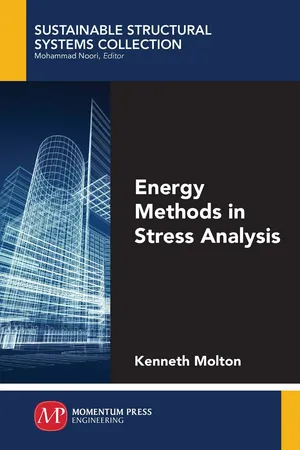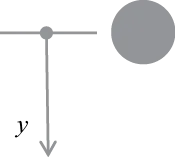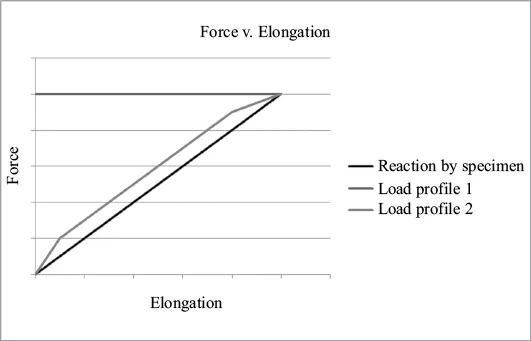![]()
CHAPTER 1
Introduction
Energy methods can provide a relationship between the applied load and the resultant deflection at any point on a structure, even where the point of interest for the deflection is not coincident with the load. They can solve problems which have multiple applied loads and where loads are applied to a structure of unusual shape. The method can provide solutions for statically indeterminate structures, that is, multiple supports, and can accommodate the rate of application of load, that is, steadily or suddenly applied.
The energy method is based on the relationship between the work done by the applied load and the strain energy in a deformed structure.
Strain energy stored in a structure may be considered as the “potential to do work”; it would of course be possible to extract work from a deformed structure.
Both strain energy and work done have the same units being “Newton*metres.”
The calculation of the stresses from strains in a loaded structure, which are typically used to predict failure, is not part of the energy method and is not necessarily covered in this text.
1.1 Free Body
The work done by a force is the product of the force and the distance travelled by that force.
For a mass “m” falling under gravity, Figure 1.1, the force is the product of its mass and gravity, and then the work done through the distance “y”:
Figure 1.1. Illustration of work done by a falling object.
In this example, the object is free falling from rest so work done is by gravity acting on the sphere. The result of this work done is initially to accelerate the sphere to its final velocity. Subsequently when the sphere is at its terminal velocity the work done overcomes the air resistance and the end result is that the work done will cause the temperature of the air to rise.
Work done in this example is equal to the loss of potential energy of the sphere, if there were no air resistance then the potential energy would be converted completely to kinetic energy and the sphere work accelerate forever and never reach a terminal velocity.
1.2 Loads on a Structure
Figure 1.2 shows a rod loaded in tension, drawn horizontally to remove inclusion of gravitational force. As in the free falling sphere example, this presents a load scenario changing with time.
Figure 1.2. Diagrammatic rod in tension.
Consider that the rod can be loaded by two separate loading profiles, in which the load is changing with time. Both loading profiles run from zero to the final predetermined load, reaching static equilibrium only at the end of the test. In order for the load to move with respect to time and elongate the specimen then it must be greater than the reaction of the specimen at any point in time. The applied load is only equal to the reaction of the specimen at static equilibrium. To illustrate this Figure 1.3 shows three curves:
Figure 1.3. Graph showing Load v. Elongation for load profiles and the reaction of the rod.
- The reaction exerted by the rod through its elongation range.
- The curve “Load profile 1” is the applied load slowly increasing. The load increases such that it always slightly greater than the reaction up to the final point of static equilibrium where they are equal.
- The curve “Load profile 2” is an applied load being equal to the final value of “Load profile 1” and constant through the elongation of the specimen.
Both load profiles reach final static equilibrium at the same elongation of the specimen as the final load is the same. The work done is by definition the product of force and distance moved and for a varying load is equal to the area below each load profile in Figure 1.3. It can be seen that the work done by each load profile is very different.
Where the force is constant at the maximum then the work done is simply:
Work done = force × distance
For load profile 1 the force increases with elongation and the area under the curve must be measured graphically or a relationship between the force and its displacement is required.
Now consider the hypothetical case in which the applied force is increasing with elongation and is greater than the reaction of the specimen at any point, but only by an infinitesimally small amount. For this hypothetical case the curve of “force v. elongation” is identical to that shown for the “reaction of the rod v. elongation” in Figure 1.3 and it may be argued that this represents the minimum work done required to elongate the specimen.
The minimum work done required to elongate the specimen is assumed synonymous with the strain energy stored in the specimen, as work done and strain energy are interchangeable.
By contrast neither total work done by load profile 1 nor load profile 2 will be equal to the strain energy stored in the rod.
The difference between the total work done by the load and the minimum work done required to elongate the specimen will affect the rate of extension, hysteresis around the final elongation at rest and possibly heating of the rod or its surroundings.
The distinction between the total work done by the load and the strain energy in the specimen is fundamental in understanding the application of energy methods. It is the relationship between the two, or more specifically their rates of change, which leads to the practical use of energy methods in structural analysis.
![]()
Chapter 2...





